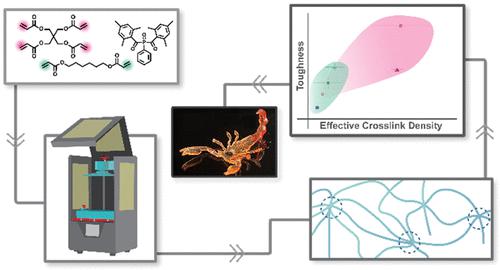当前位置:
X-MOL 学术
›
ACS Appl. Polym. Mater.
›
论文详情
Our official English website, www.x-mol.net, welcomes your feedback! (Note: you will need to create a separate account there.)
Influence of Cross-Linker Functionality and Photoinitiator Loading on Network Connectivity and Actuation in 3D-Printed Model Thermosets
ACS Applied Polymer Materials ( IF 5 ) Pub Date : 2024-03-20 , DOI: 10.1021/acsapm.3c03217 Kristian M. Van de Voorde 1 , Susan K. Kozawa 1, 2 , Jordan A. Mack 3 , Chase B. Thompson 4
ACS Applied Polymer Materials ( IF 5 ) Pub Date : 2024-03-20 , DOI: 10.1021/acsapm.3c03217 Kristian M. Van de Voorde 1 , Susan K. Kozawa 1, 2 , Jordan A. Mack 3 , Chase B. Thompson 4
Affiliation

|
Vat photopolymerization additive manufacturing has gained traction as a platform to produce high-performance materials for a wide range of applications in areas such as tissue engineering and soft robotics. However, a gap in the current knowledge remains on how seemingly minute variations during resin formulation can impact the properties of these cross-linked, 3D-printed parts, especially with respect to how network inhomogeneity develops within the print process in (meth)acrylate resins. In this study, a series of acrylate-based model resins are printed with precise control over cross-linker functionality (difunctional or tetrafunctional) and photoinitiator concentration to influence the resulting structure of the cross-linked network. A significant impact on connectivity and inhomogeneity is observed as initiator content is increased, but this relationship is not consistent across cross-linkers with varied functionalities. The shifts in thermomechanical properties are probed by time–temperature superposition (TTS) studies which highlight that greater inhomogeneity results in more fragile─or temperature-sensitive─networks and that this is a result of the changes in effective cross-link density across the prints. These small changes in the nano- and microscale structuring of the 3D print critically influence its functionality when incorporated into a printable hygromorphic actuating bilayer. Moreover, the reported findings emphasize the need for a deep understanding of the polymerization pathways utilized in resin 3D printing, as it is the foundation for precisely predicting the thermomechanical and functional properties of 3D-printed cross-linked systems.
中文翻译:

交联剂功能和光引发剂负载对 3D 打印模型热固性材料网络连接和驱动的影响
还原光聚合增材制造作为生产高性能材料的平台而受到关注,这些材料适用于组织工程和软机器人等领域的广泛应用。然而,在树脂配方过程中看似微小的变化如何影响这些交联 3D 打印部件的性能方面,目前的知识仍然存在差距,特别是在 (甲基) 丙烯酸酯树脂的打印过程中网络不均匀性如何发展方面。在这项研究中,通过精确控制交联剂官能度(双官能或四官能)和光引发剂浓度来印刷一系列基于丙烯酸酯的模型树脂,以影响最终的交联网络结构。随着引发剂含量的增加,观察到对连接性和不均匀性的显着影响,但这种关系在具有不同功能的交联剂之间并不一致。通过时间-温度叠加(TTS)研究探讨了热机械性能的变化,该研究强调,更大的不均匀性会导致更脆弱(或温度敏感)的网络,这是印刷品上有效交联密度变化的结果。当将 3D 打印纳入可打印的湿态驱动双层时,这些纳米和微米级结构的微小变化会严重影响其功能。此外,报告的发现强调需要深入了解树脂 3D 打印中使用的聚合途径,因为它是精确预测 3D 打印交联系统的热机械和功能特性的基础。
更新日期:2024-03-20
中文翻译:

交联剂功能和光引发剂负载对 3D 打印模型热固性材料网络连接和驱动的影响
还原光聚合增材制造作为生产高性能材料的平台而受到关注,这些材料适用于组织工程和软机器人等领域的广泛应用。然而,在树脂配方过程中看似微小的变化如何影响这些交联 3D 打印部件的性能方面,目前的知识仍然存在差距,特别是在 (甲基) 丙烯酸酯树脂的打印过程中网络不均匀性如何发展方面。在这项研究中,通过精确控制交联剂官能度(双官能或四官能)和光引发剂浓度来印刷一系列基于丙烯酸酯的模型树脂,以影响最终的交联网络结构。随着引发剂含量的增加,观察到对连接性和不均匀性的显着影响,但这种关系在具有不同功能的交联剂之间并不一致。通过时间-温度叠加(TTS)研究探讨了热机械性能的变化,该研究强调,更大的不均匀性会导致更脆弱(或温度敏感)的网络,这是印刷品上有效交联密度变化的结果。当将 3D 打印纳入可打印的湿态驱动双层时,这些纳米和微米级结构的微小变化会严重影响其功能。此外,报告的发现强调需要深入了解树脂 3D 打印中使用的聚合途径,因为它是精确预测 3D 打印交联系统的热机械和功能特性的基础。



























 京公网安备 11010802027423号
京公网安备 11010802027423号